If you have ever wondered how to make traditional French puff pastry from scratch, this will be your ultimate baking guide! Home made puff pastry (Pâte Feuilletée in French) might seem like a challenge, but the buttery taste and crisp texture are well worth the effort! I will show you how to make melt-in-the-mouth puff pastry in a relatively easy, straight forward way, so you'll never want to buy store-bought again.

Jump to:
- 💡 What is Puff Pastry (French Pâte Feuilletée)?
- 💡 What are the 3 types of puff pastry?
- 💡What is the difference between rough puff and traditional puff pastry (that is also called full puff pastry or classic puff pastry)?
- 💡How many layers are in French puff pastry?
- 💡Why make homemade puff pastry?
- 💡 Is puff pastry the same as crescent roll?
- 💡Is puff pastry the same as phyllo dough?
- 🌟 Why this is the best French puff pastry recipe
- 📝 Ingredient notes
- 👩🍳 How to make this Classic French puff pastry recipe
- ✨ Flavor variations & Substitutions
- 🎓 Expert tips on making French puff pastry
- 🥣 Equipment Notes
- ❓Homemade French Puff Pastry FAQs
- 🍰 How to use Puff pastry
- How to make Traditional French Puff Pastry
💡 What is Puff Pastry (French Pâte Feuilletée)?
French puff pastry is a form of pastry characterized by its many layers, crisp exterior, and buttery taste. It was invented by accident in the 17th century by a French apprentice chef called Claude Gelée. He was trying to make a rolled butter cake for his father, and ended up creating this wonderful flaky, light, buttery layered pastry instead!
Classic puff pastry (or pâte feuilletée in French) is made with a sheet of cold butter (the beurrage) that is laminated into a simple flour-based dough (the détrempe), by being rolled out and folded multiple times (the tournage).
The result is a dough that has layers of cold butter within it, and as the puff pastry cooks, the water content in the butter evaporates to create steam. The steam pushes apart the layers of the puff pastry dough expanding its volume to several times its original height.
French puff pastry is a delicious, buttery, crisp, and light pastry that melts in the mouth. Puff pastry can be the perfect base for many desserts like Mille feuille, Apple turnover, Napoleon cake, French King cake, etc.
💡 What are the 3 types of puff pastry?
There are 3 types of puff pastry, ’half,’ ‘three-quarter’ or ‘full’. The name refers to the ratio of butter to flour in the dough. Traditional French puff pastry is full puff pastry. There is also inverted puff pastry, or inverse puff pastry, which is made the opposite way to classic puff pastry by folding the lean dough inside the butter block and not the other way around.
💡What is the difference between rough puff and traditional puff pastry (that is also called full puff pastry or classic puff pastry)?
A rough puff pastry is a faster, easier way of making puff pastry that is not quite the same but can still work really well in desserts like Mille Feuille or Turnovers. Rough puff pastry is still made by folding layers of pastry multiple times to achieve the layers, but the butter is mixed with the flour before rolling out and folding and is not laminated into it.
There is slightly less rise in rough puff pastry because the steam from the chunks of butter will not create the same even rise as the hundreds of layers of butter in classic puff pastry.
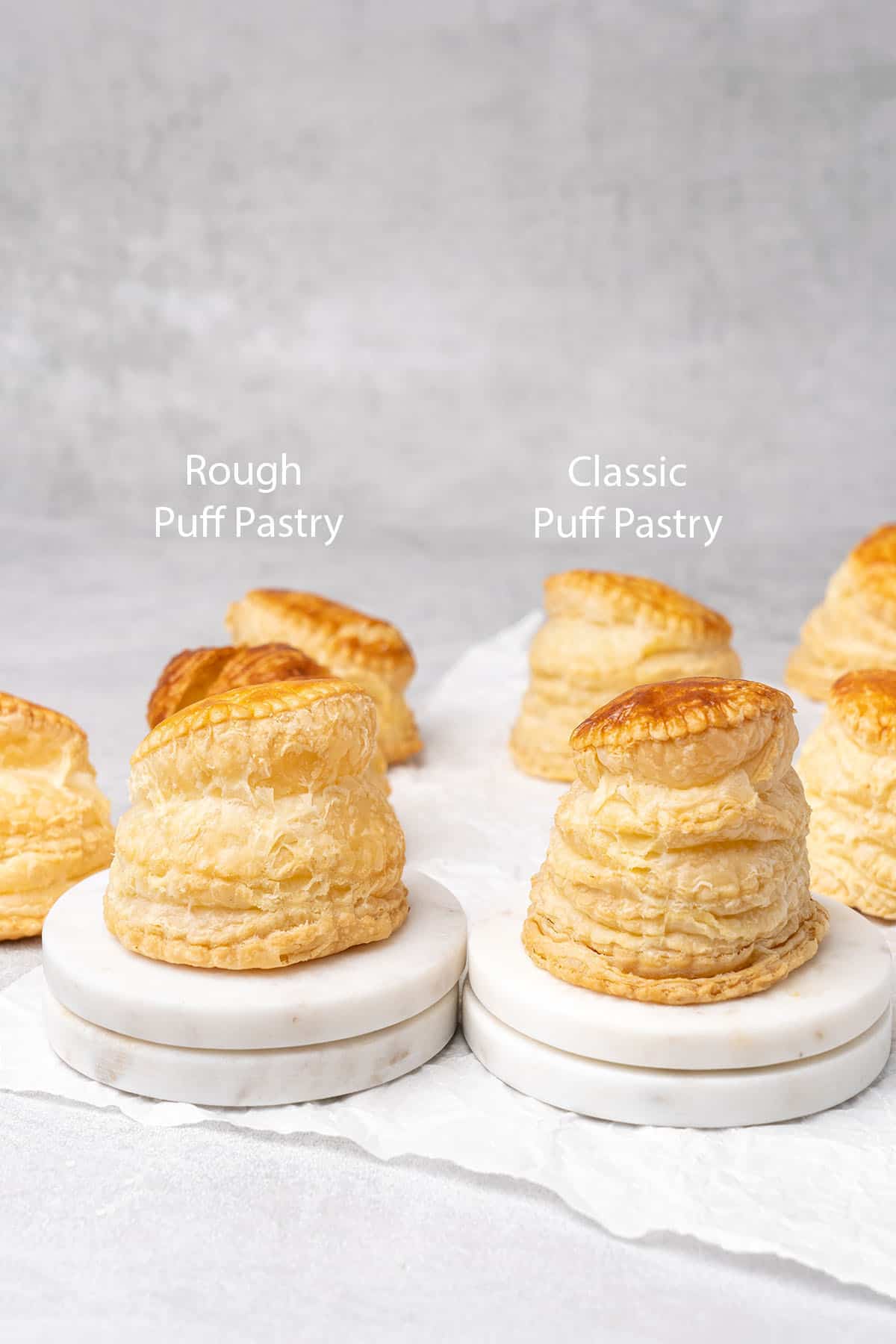
💡How many layers are in French puff pastry?
Traditional French puff pastry has 729 layers which can seem hard to believe! But have you ever heard of the dessert Mille-Feuille? It means 'thousand leaves' and gets its name from layers and layers of puff pastry in the dish.
As you fold and turn the classic French puff pastry dough, the layers compound and that's how you create so many. The first fold creates 3 layers, then overall over the course of 6 folds there will be 3*3*3*3*3*3=729 layers!

💡Why make homemade puff pastry?
There is nothing quite like the buttery flavor of homemade puff pastry! Plus, the sense of achievement afterward tastes almost as good. Making French puff pastry from scratch is a lot of fun, and takes work and precision so it's very satisfying. You can use your homemade puff pastry for dishes like these turnovers or a traditional French king cake.
💡 Is puff pastry the same as crescent roll?
No, puff pastry is not the same as a crescent roll. Crescent rolls are made with a yeasted dough that is further enriched by milk and eggs and proved before baking to achieve rise. There is no lamination process, making them faster and easier to make and they have a different flavor and texture.
Croissants, however, are made with a dough more similar to puff pastry. Although, it is enriched with yeast and eggs similar to crescent rolls so still not exactly the same.
💡Is puff pastry the same as phyllo dough?
No, puff pastry and phyllo are not the same. Phyllo pastry (also known as filo pastry) is a dough made with flour, water, and oil and stretched out into paper-thin sheets. The sheets of phyllo dough are then brushed with butter (or more oil) before being layered on top of one another manually and baked. Phyllo pastry is very light, crisp, and brittle and is used a lot in Greek and Turkish cuisine, for example, in Baklava.
🌟 Why this is the best French puff pastry recipe
- It's detailed: Baking is all about precision so my puff pastry diagrams, process images, and detailed step-by-step instructions for puff pastry will give you all the help you need.
- It's delicious: You will never get over how delicious traditional French puff pastry is. It's such a unique, rich, buttery taste and light, crisp texture, and nothing compares!
- It's satisfying: You know how much I love baking, and whilst making homemade puff pastry from scratch is quite advanced, it is also so satisfying. I have included all of my tips and tricks in this traditional puff pastry recipe!
If you love French desserts, make sure to check out my ultimate best French pastries list with recipes!
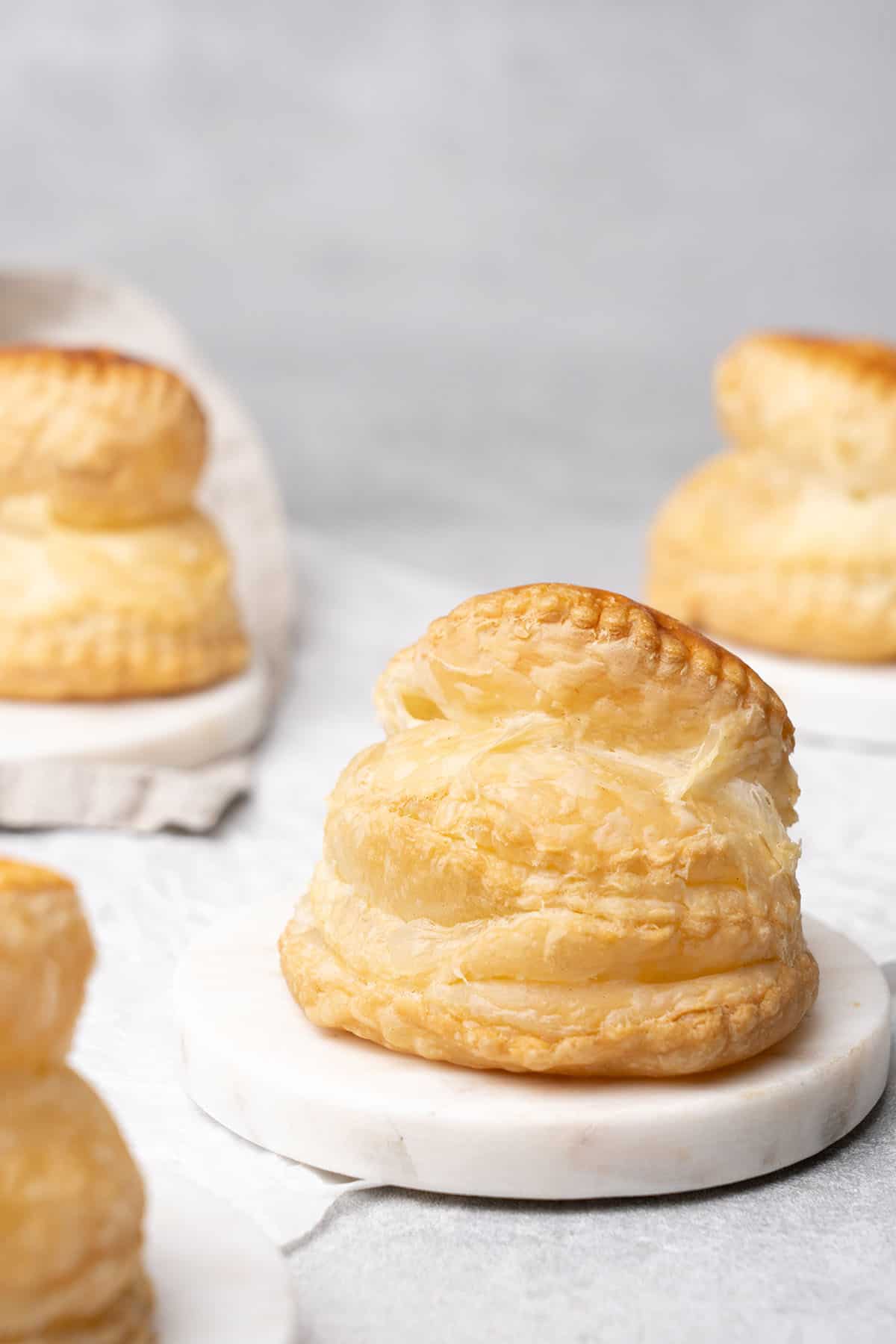
📝 Ingredient notes
Puff pastry is actually made from only a few, very basic ingredients. It is the way they are combined and worked together that is more complex and challenging! Here are the ingredients you will need if you're wondering how to make puff pastry from scratch. I have included a special extra ingredient that will really help make it a success.

- Bread flour: Puff pastry needs flour with high protein content to get the right gluten development so buy flour labeled as strong flour, or as bread flour. Alternatively, use all purpose flour. To learn more about flour, read my flour guide.
- Salt: Salt is a flavor enhancer and will bring out the buttery flavor so be sure to use it even if you are using this puff pastry for dessert.
- Unsalted butter: We use the butter in this French puff pastry recipe in two ways, a smaller amount will go into the lean dough and the larger amount will make the butter block that needs to be laminated into it to make the puff pastry dough. Use butter with at least 82% fat content, and if you can access 84% butter then it's even better. Remember, the more fat, the more flavor. Did you know you can make your own butter?
- White vinegar: A small amount of vinegar helps relax the dough and makes it easier to roll out without breaking, so it is an essential part of this recipe. But don't worry, you won't be able to taste it!
- Cold Water: Steam is the rising agent in puff pastry so, in addition to the water content in the butter, we need to bind the lean dough with water too. The water needs to be very cold. Keep it in the fridge and then place it into the freezer just before use.
🛒 You’ll find detailed measurements for all Ingredients in the printable version of the Recipe Card at the bottom of this post
👩🍳 How to make this Classic French puff pastry recipe
1. How to make the dough for puff pastry
- Measure the water and vinegar into a bowl and chill it in the freezer.
- Prepare your stand mixer with the dough hook attachment.
- Sieve the strong bread flour to remove lumps and mix it with the salt before putting them into the stand mixer.
- Melt the smaller amount of butter and allow it to cool slightly before adding it to the flour.
- Turn the mixer to the lowest speed, and slowly start adding the water-vinegar mixture to the dough. Knead the dough for a minute, still at low speed, until it comes together.
- Now knead the dough by hand for another minute until it becomes smooth, but do not overwork it.
- Wrap the dough in plastic food wrap and refrigerate overnight to let the gluten develop so it has enough elasticity.
💡 Top Tip: You may not need to add all of the water specified in this recipe, it will depend on the flour you use. All ingredients and conditions vary, so use your judgment and stop adding water once the dough is moist, but not wet.

2. How to make the butter block
- Take a piece of parchment paper and fold it so that each half measures 20x20cm / 8x8 inch.
- Slice the butter into chunks and allow it to soften slightly.
- Place the butter in between the folded parchment paper.
- Hit and roll over the butter with a rolling pin so that it fuses together again and forms one flat square butter block that measures 20x20cm /8x8 inches and is even in thickness.
- Chill the butter block in the fridge before use.
💡 Top Tip: Alternatively, place the butter chunks inside a plastic freezer bag that is the right size.
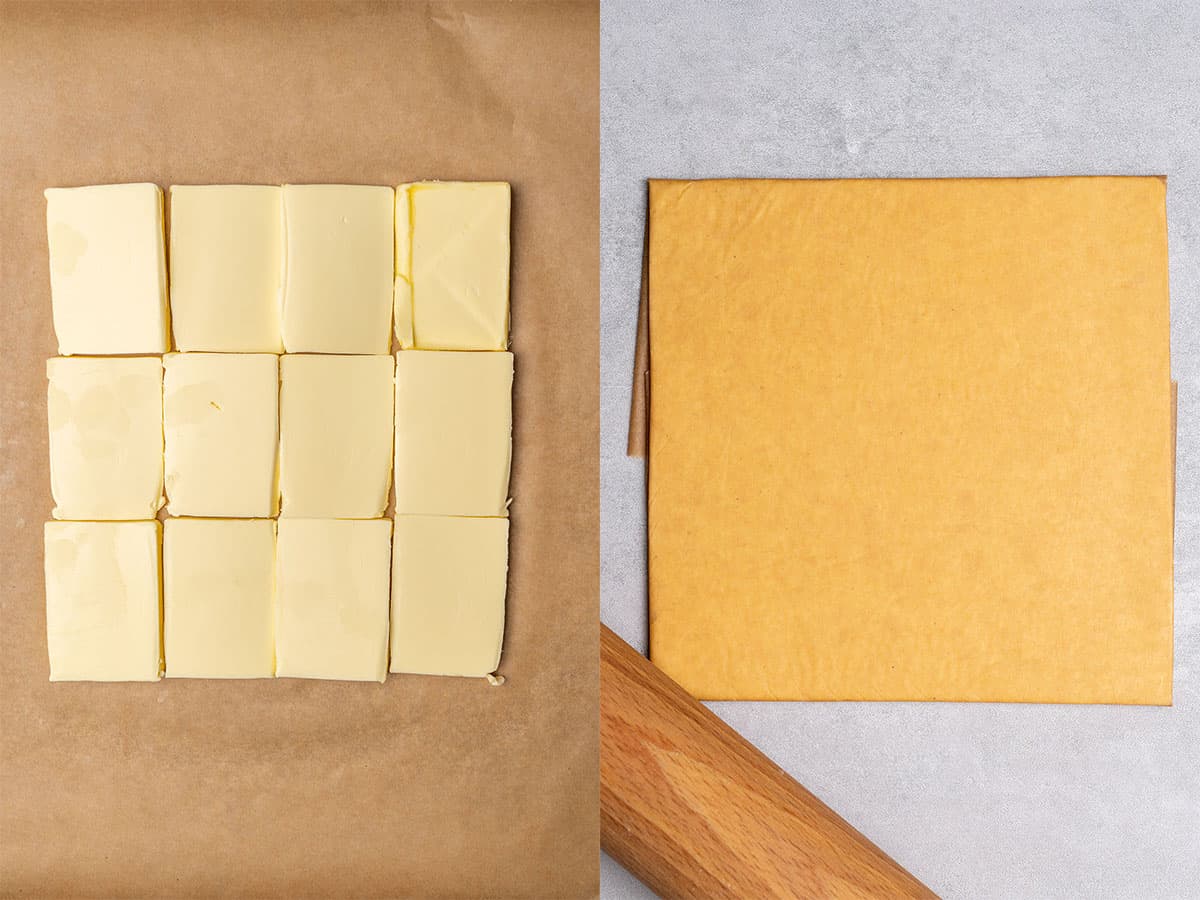
3. Puff pastry lamination step-by-step
Before you begin: Temperature is everything when it comes to making homemade puff pastry. If the dough is too warm the butter will start to melt but if it's too cold, it will easily break. It needs to be pliable, but if at any point in the lamination process the dough becomes too flexible or sticky, quickly wrap and chill in the fridge for 15 minutes before continuing where you left off.
- Take the butter block out of the fridge and allow it to soften just until you can slightly bend the block and it isn't so stiff that it will break.
- Roll out the dough into a rectangle on a lightly floured surface or silicon mat. It needs to be twice the length of the butter block with a bit of room around the edges, measuring 25x45cm / 10x18 inch.
- Place the butter block onto the bottom half of the lean dough, and fold the dough down over it. Carefully seal all 4 sides by pressing them gently together. If the dough is still cold enough, move on to the folding process detailed below, but if not, wrap and place it into the fridge for 15 minutes.
- Roll the dough that now has the butter block inside it into a rectangle lengthways in front of you, measuring 25x45cm / 10x18 inch.
- Make your first fold. Dust off any excess flour and fold the top third down, and then fold the bottom third up over it like a letter. There will be an open edge at the top, and a closed edge at the bottom.
- Rotate the pastry block 90 degrees clockwise so that the open edge runs down the block's right side. This process is your first fold.
- Make a second fold by repeating steps 5 and 6 so roll out the dough into a 25x45cm / 10x18 inch rectangle, fold it up in thirds, and rotate 90 degrees to the right. Try to line up the edges of the block of puff pastry dough to ensure an even thickness and distribution of cold butter layers.
- Rest the dough in the fridge, wrapped in plastic food wrap for 1-2 hours.
- Repeat this process a further 2 times so that you make 6 folds in total, but do not make more than 2 folds at once without resting the dough in between. If you are concerned about overworking the dough and bringing up the temperature, rest it in between each fold instead.
💡 Top Tip: To keep the dough cold but pliable enough for rolling, you may need to take it out of the fridge and put it back in again a few times during the resting period. What we are looking for is a cold pastry that does not tear or stick but warm enough to be able to roll.
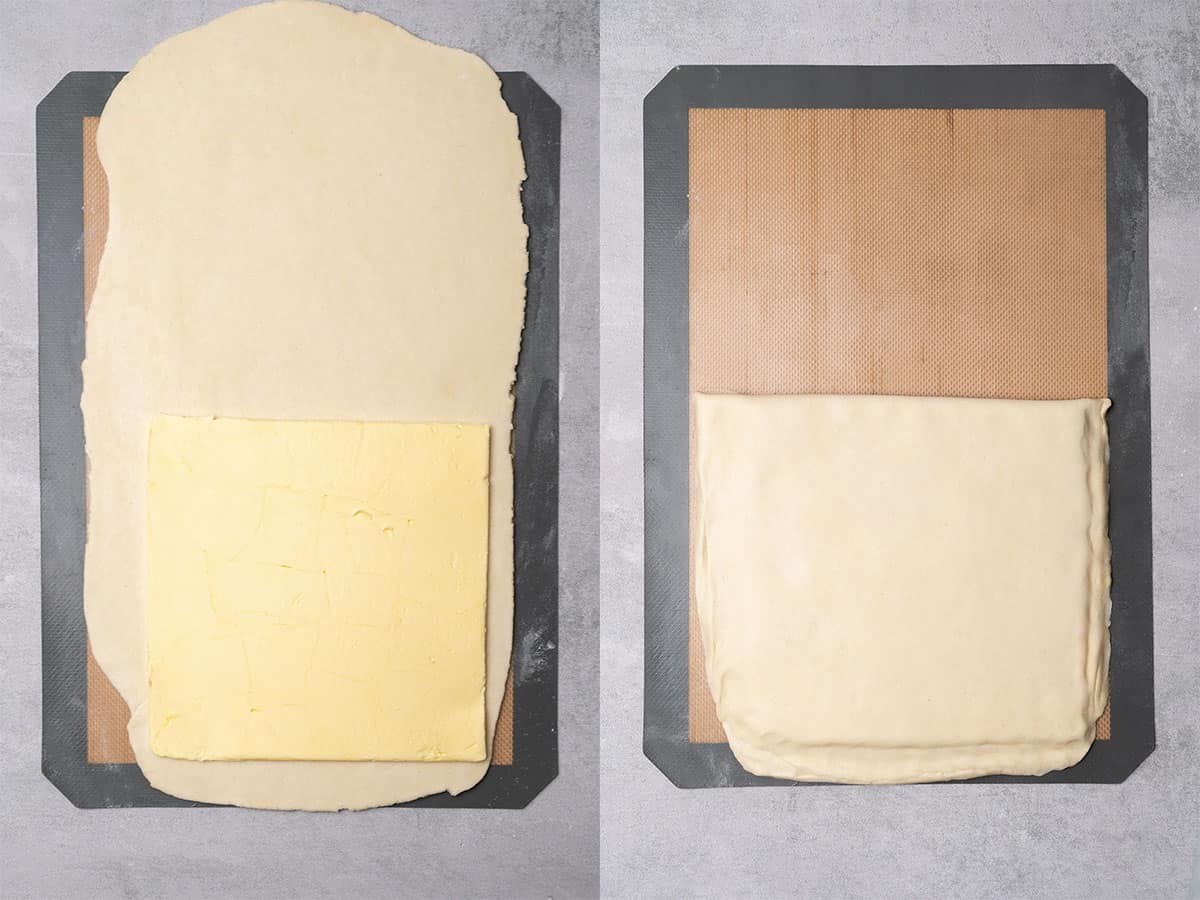

4. How to bake puff pastry
- After your 6th and final fold, chill the traditional puff pastry for a further 4 hours before using it in your chosen recipe.
- Roll out the puff pastry dough or cut shapes like circles to make puff pastry balls for example.
- Preheat your oven and bake according to the recipe.
💡 Top Tip: Puff pastry needs a hot oven to achieve the right rise, but you might need to start baking at a high temperature, before turning the oven down to allow other ingredients to cook correctly.

✨ Flavor variations & Substitutions
Now that you've mastered how to make classic puff pastry, you can try all sorts of French puff pastry recipes and other variations.
To make colored puff pastry, mix powdered food coloring with the flour before sieving together to remove any lumps.
Flavors like cocoa powder can be added to the flour to make chocolate puff pastry before sieving together and making the dough. Or you could add spices like a pinch of ground cinnamon!
Why not try stirring some orange zest into the flour before making the lean dough to give your classic puff pastry a delicious citrus flavor?
To make French puff pastry savory, add slightly more salt to the flour.
Brush an egg wash over the puff pastry before baking to give a rich golden, and glossy top. Learn all about egg wash here.
If you are baking around a dietary restriction or preference, I have some baking guides that will help. Check out my butter substitution guide here.
🎓 Expert tips on making French puff pastry
- Weigh your classic puff pastry ingredients by the gram using a set of digital scales.
- Use a silicon baking mat to turn and fold to avoid handling the dough too much.
- Always do your patisserie work in a cold kitchen to avoid the butter melting whilst you work the French puff pastry dough. Aim to have the temperature in the kitchen below 18C / 64F.
- Try to use a minimum amount of dusting flour and use a pastry brush to brush off any excess before folding.
- Always wrap the puff pastry in plastic food wrap before it rests between folds so that it doesn't dry out and form a crust.
- Puff pastry needs a hot oven, so use an oven thermometer to ensure yours is at the right temperature before you bake.
- Be aware of how much puff pastry can rise in the oven! You don't want to squash your French puff pastry tower by putting another oven shelf right above it.
🥣 Equipment Notes
Precision is essential in baking, so always weigh your ingredients using a digital scale.
To avoid handling the dough too much and to ensure even mixing, use a stand mixer.
A good quality rolling pin is a key piece of equipment in baking. Especially, in French puff pastry where even pressure and minimum handling is so important.
I use a silicone baking mat to help me roll dough to the right size. As well as minimize the amount I need to touch the French pastry dough with warm hands. It also helps the dough not to stick, so I don't need to use as much dusting flour.
All ovens vary, and baking at the right oven temperature is vital. Make sure your oven is correct by using a digital oven thermometer

❓Homemade French Puff Pastry FAQs
Store puff pastry wrapped in plastic food wrap in the fridge and use it within 2 days.
Yes, you can freeze puff pastry once you have rested it after its final 6th fold. Double wrap in plastic food wrap and then foil to seal completely and use it in your French puff pastry dessert within one month.
The butter lamination itself is the only rising agent in traditional puff pastry, there is no yeast in puff pastry, neither baking powder.
Croissants, pain au chocolate, and Danish pastries are not made with classic puff pastry but they are made of laminated dough and have the same buttery layers. Their pastry also contains yeast as a further rising agent and is sometimes enriched with eggs too.
An inverted puff pastry is when the flour dough is wrapped in a sheet of butter and then rolled and folded multiple times, rather than the other way around.
Both puff pasty and choux pastry use steam as their rising agent that forms gaps or pockets that can be used for fillings. But choux pastry contains less butter, is not laminated, and contains eggs as well. Choux pastry is used in recipes like a French cream puff, and french cream filled pastry items like eclairs and croquembouches.
Puff pastry is quite delicate so using it as a traditional pie crust won't show it off to its best advantage (or showcase your hard work!). It does work well as a crispy base for toppings, as a topping for pies like Tarte Tatin, or more hand pie-like pastries like turnovers.
This is likely because the dough was too warm as you were working it, causing the butter to melt into the lean dough and not remain in layers. It is essential to keep it chilled throughout the lamination process. It could also be that your oven was not hot enough so the butter melted too slowly as it baked.
It might be that the oven was not hot enough, or you did not cook it for long enough. Or, there were other items in the oven that disrupted the baking and added more moisture to the environment. Bake puff pastry on its own on the middle shelf of the oven.
French puff pastry is also known as classic puff pastry, traditional puff pastry, or full puff pastry. Or, by its French name pâte feuilletée.
🍰 How to use Puff pastry
Check out my favorite puff pastry desserts!
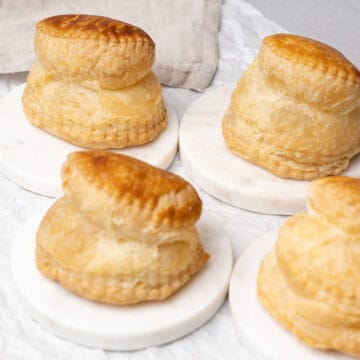
How to make Traditional French Puff Pastry
Ingredients
For the Puff pastry
- 250 g (2 cups) Bread flour high protein content flour
- ½ teaspoon Salt
- 50 g (¼ cups) Unsalted butter melted but not hot
- ½ teaspoon White vinegar
- 125 g (½ cups) Cold Water very cold
- 180 g (¾ cups) Unsalted butter cold - for the butter block
US customary cup measurement is an indicative figure only. Measure the ingredients with a digital scale by weight (gram). Baking is art but also science which requires precision and accuracy.
Instructions
DAY 1
Prepare the puff pastry dough
- Measure water and vinegar, mix them in a small bowl, and place them into the freezer
- Prepare your Stand mixer with the hook attachment and mix high protein content flour with salt
- Melt butter (the smaller amount) and once the butter is not too hot mix it into the flour
- Start adding the water-vinegar mixture to the dough while your mixer is at the lowest speed. Be mindful of the water, you might not need all of it, stop adding water as soon as the dough is moist enough but you do not want to make it wet. Once water is added, knead the dough in the Stand mixer for another minute at low speed just until it comes together.
- Then, using your hand, gently knead the dough for another minute just until it becomes smooth. Do not overwork the dough
- Wrap the dough into a plastic wrap and refrigerate overnight
Prepare the butter block
- Prepare a 20cm / 8 inch square butter block and refrigerate it
Day 2
Lamination process
- Take the butter block out of the fridge. We want to wait for the perfect moment to seal the butter into the dough; when you can slightly bend the butter block without breaking it. This is called when the butter is pliable.
- Use Silicone baking mat to make the rolling and folding easier. Start rolling the dough into 25x45cm / 10x18inch, which is 2x bigger (plus some extra) than the size of the butter. When the butter reaches the perfect temperature, place it onto the bottom part of the dough, fold the dough over the butter block and carefully seal all 4 sides.
- If the dough is still cold enough start the folding process as per below, if not, place it into the fridge for 15 minutes.
- Prepare a 6-fold puff pastry; Roll dough into 25x45cm / 10x18inch, fold the top third into the middle, then fold the bottom third into the middle. Now you will get an envelope shape that has an "open edge" on the top and a "closed edge" on the bottom. Rotate by 90 degrees to the right so you will get the "open edge" on the right and the "closed edge" on left.
- Your first fold is done, repeat it 6x. Rest the dough for 1-2 hours either in between each fold (if your kitchen is warm) or in between 2 folds. Do not make more than 2 folds at once without resting the dough.
- After the 6th fold, refrigerate the puff pastry dough for a minimum of 4 hours before using
Baking
- Bake the pastry accoridng to the recipe.
Notes
- Make sure to measure the ingredients using a digital scale
- Use a silicon baking mat to turn and fold the puff pastry dough. The mat not only prevents the dough from sticking but also acts as a ruler while rolling
- Try to work in a cold kitchen environment under 18C / 64F. If at any point the pastry is too sticky, pop it back to the fridge to chill before proceeding with the next step in the recipe
- Try to use a minimum amount of dusting flour and use a pastry brush to brush off any excess before folding.

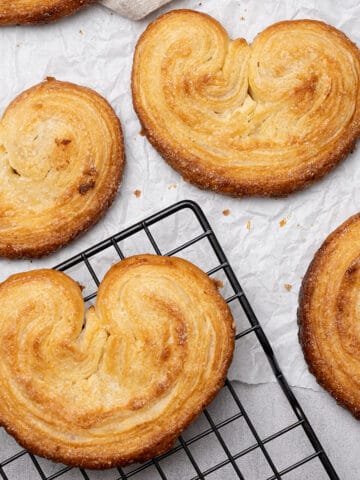
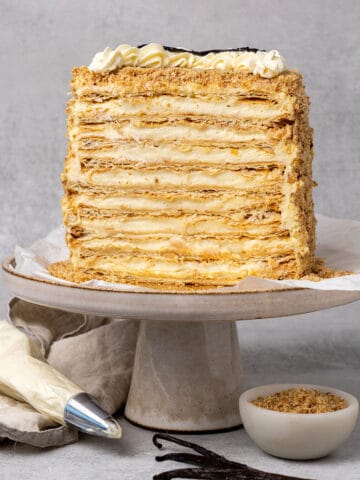


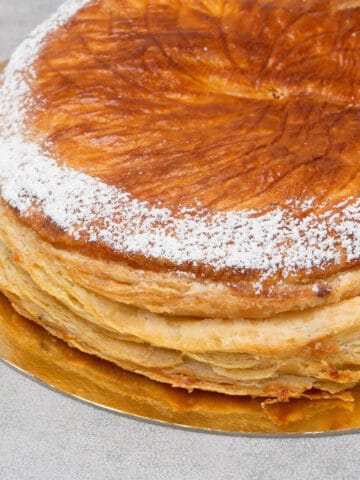


Padma
not even any layers? id get fired if i made this in a bakery. is this meant for crossaints and danishes? it's not puff pastry if so...
Katalin Nagy
I agree you should get fired from a bakery if don´t know the difference between croissant dough / Danish vs puff pastry. Here is a helpful summary: https://www.spatuladesserts.com/cream-cheese-puff-pastry-danish/#%f0%9f%8c%9f-what-is-the-difference-between-puff-pastry-and-danish-pastry
ida
hi, can we use this recipe to make the NY Rolls or Supreme Rolls?
Katalin Nagy
I think it is croissant dough, not puff pastry.
Elisha Lei
Si much better than shop bought one!
Elisha Lei
so much better than shop bought one!!!